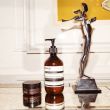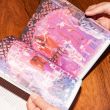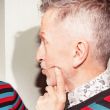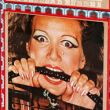'I grew up in this grody town just outside of London called Reading, which was an industrial kind of town back then. The environment was so gritty and postwar—there wasn’t an abundance of anything. But from an early age I was interested in fashion and glamour, and my mom was a big believer in maquillage. She was a lot more put together than the other mothers on our street...her style was very 1940s and she kind of looked like Bette Davis, with the upswept rolled hair and the overpainted lips. She always wore a longline girdle even though she was really skinny, and she smoked. She was a very film noir chick.
The '50s were still very grim, but then in the '60s, everything went into Technicolor. My mom used to get magazines, and one that she subscribed to was Nova, which was very avant-garde. When she would get her hair done, I would sit and read it. It was very far out—that whole English flamboyance. You'd see Rod Stewart and he'd be wearing an Ossie Clark blouse with satin trousers. Around that time I became very focused on buying clothes. Back then your parents didn't give you money, you had to get a job, so when I was 16 I got a job in a cork factory making bottle tops. I was like, 'Great! Now I can go into London and buy clothes!' I worked for awhile and then got it in my head that I was going to go to college—my parents hadn't gone, but I had great O Level results, and I got into Manchester University. I went for psychology and art history. It was great because Manchester was much bigger than Reading, and it was kind of like a gateway to living in London.
After college, I worked at a department store in my town called John Lewis with my friend who looked like Ziggy Stardust. We moved to London together to have a fabulous time—we were really focused on being groovy and having certain clothes and going to certain places. I worked in a shop near Savile Row selling women’s fashion, and my friend became a cross-dressing cabaret artist. We got to know all kinds of people...a lot of my friends back then worked for Zandra Rhodes, and I also got to know a lot of people who did window display. I thought that would be something I would like to do since being a salesperson got boring. I did a lot of freelance work on Portobello Road and Savile Row—I would go in and say, ‘Who does your windows?’ I did that for Shirley Russell, who had a shop selling and renting vintage clothes. She had Schiaparelli and Fortuny dresses—incredible things! Another job I had was for Tommy Nutter, who was a very trendy tailor on Savile. Mick Jagger wore a Tommy Nutter suit when he married Bianca. I did a window that was proto-punk with stuffed rats and trash cans and these very glamorous tuxedos. This guy came in and said, ‘I like your window, you should come work for me in LA.' I told my roommate and he said, 'Where's LA?' And I said 'I'm not sure.' But I ended up going!
So, I went to LA to work at Maxfield. People said to me, ‘You’ll never get your green card because they don’t give them to gay people.’ It was open discrimination. On the form it said, ‘Are you homosexual?’ That disqualified you from getting a green card! Of course, I lied. I worked at Maxfield for Tommy Perse, who is a brilliant fashion retailer. Maxfield is and was one of the greatest, most brilliant owner-operated stores. Everyone from Cher to Natalie Wood to Fleetwood Mac would shop there. They paid full retail! That was a mistake, giving clothes to celebrities, because they are the only people who really need them. I always thought that was a bad move. I find kissing a celebrity’s ass utterly unbearable, I don’t know how people do it.
I worked there for eight years and then this friend of mine said to me, ‘We should go to New York and volunteer to work with Diana Vreeland at the Costume Institute.’ I said, ‘You’re kidding! I’m an accomplished display person, I’m not volunteering anywhere!’ I went there and I actually talked my way into a paying job working on the Costumes of Royal India exhibit. I slept on a friend's floor and worked at the Costume Institute. It was a four month gig. Back then, at the opening reception, anybody could buy a hundred dollar dessert ticket, so you would get to go to the Met for the party after dinner ended. Hundreds of people did it. All these fashion riffraffs would buy these hundred-dollar tickets and storm the place! It was so fun. It was there that my friend introduced me to Gene Pressman, who owned Barneys. He said, 'I'm familiar with your work at Maxfield, you should come to work for me.'
By then I was 33, so I thought, ‘Maybe I should get a grown-up job and medical insurance and all that stuff.’ I relocated and moved to New York and I’ve been here for 30 years. I was in charge of windows [when I first started out at Barneys]. Then I worked in advertising and store design. I was Creative Director for most of my time at Barneys and now I’m Creative Ambassador-at-Large–since 2010. It’s more of a PR-oriented position, you know, hosting events and talking to press. It was my dream job. It still is!
My book [Confessions of a Window Dresser] came out in 1998 and really started my career as a writer. I wrote columns for the New York Observer for 10 years and I’ve written six books. Fashion is hard to write about because it’s very much a visual thing. I like writing about humorous things, like culture. I write culture for Slate now—I just wrote about the anniversary of the Valley of the Dolls. I never thought I'd be a writer. My career has been about jumping on things and being thrown into them. It’s a millennial thing to have this sweeping vision of your future and your career. No wonder you all have anxiety disorders! It must be horrendous to live with that. For my generation we were all like, ‘Oh, that could be groovy and fun…’ It was about low expectation, good work ethic, and a willingness to throw yourself at anything, basically. The real focus was what you were going to do on Friday night! I think it's the opposite now.
I know the beauty world inside and out—I used to write all the copy for the cosmetics mailer for years. And Barneys beauty is legendary. We launched François Nars! But I'm a believer that nothing is important. I use this Aesop Rind Concentrate Body Balm, but I use it for everything—if my face is a bit dry I slap it on my face because I can’t be bothered. I once had a facial and I thought I was going to die! I thought someone was clog dancing on my face. I go to this fantastic woman, Grace Pak, once a year, and she just slashes off anything that's problematic. I’ll be with a group of friends and they’ll say, ‘Your skin looks great!’ and I’ll be like, ‘What did it look like the last time? Like shit?’ I just don’t think that way. I’m lucky that I’m aging OK and I don’t think that [having plastic surgery] is serving my interest at all. I think men look fine when they’re craggy.
In the shower, I'll wash my hair once or twice a week with Aesop Shampoo—and I get it on my face, and that’s enough [to wash my face]. I’m so feral! I was raised by wolves. I use Vitaman Hold Factor 2 Pomade to style my hair. I put some on my hands, warm it up a bit and then push it into my hair. The less you do your hair the better, I think, for men...it can look very artificial. If I were going bald I would do a hat or like a Warhol wig, where it’s a wig and everyone knows it’s a wig, and not some surreptitious toupée, which I think is really cringe-making. I would get a wig that’s blue. I used to love to throw on a colored wig!
I go to the gym every day, but I also do tai chi. It’s more meditative and great for your posture. The way to look and feel young is through physical exercise. That, to me, is more important. I love to paddleboard, bike and run, but I do the stairs and elliptical. I’m one of those annoying people who enjoy it. I learned [tai chi] from this wonderful guy called Dr. Lam on the internet because it’s not so complex. He’s based in Australia and everything I’ve learned to this point I’ve learned from looking at the computer. I think it’s one of those things that you don’t fully understand until you’re over 60. It’s both a health thing and a vanity thing. I’ve never eaten junk food, and I also take a lot of vitamin D.
I never got into makeup. I plucked my eyebrows—that's it! It was the glam rock [era] and I had a unibrow! I thought, ‘Oh yeah, I should pluck them,’ because I loved Roxy Music and Bowie, and they were all full-on with the makeup. I always wished that I had [been into makeup]. I was always in a hurry, but I admired when people would do amazing makeup. It wasn’t because I thought it was feminine—I thought it was great! I would sit and get makeup done for those VH1 appearances and then they would say, ‘Don’t you want to look at yourself?’ And I would be like, ‘Oh. Right. I should, I guess.’ I’m not vain, really.
I’m still very into glam rock. I’ll wear sweatpants and a t-shirt when I go to the gym, but never out. I never have anxiety about what I’m going to wear. I understand it, but that’s the thing with fashion today—there isn’t one way to dress. You just have to self-invent and self-create. People care very little about what you’re wearing. I think it’s self-indulgent to stress about how you look—just throw it on! No one really cares, so just have fun with it.”
—as told to ITG
Simon Doonan photographed by Tom Newton at his home in New York on February 1, 2016.
Read about how Oribe got his start as a hair salon receptionist and how Linda Rodin mixed her first Olio Lusso in a coffee mug in The Professional.
















